Pre-Calculus 11 Student Edition Chapter 3 Quadratic Functions
Page 180 Problem 1 Answer
It is given that she sold mukluks for $400 per pair, and she sold 14 pairs.
She predicts that for every $40 increase in price, she will sell one fewer pair.
we have to complete the table by given information.
The completed table is shown as
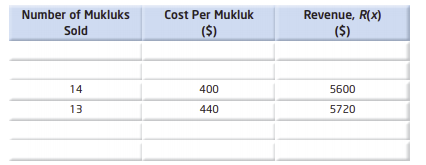
Revenue=16×320=5120
Revenue=15×360=5400
Revenue=14×400=5600
Revenue=13×440=5720
Revenue=12×480=5760
Revenue=11×520=5720

Therefore, we see that while increasing the price, we see that there is increase in the total revenue but at one point the total revenue is decrease when number of Mukluks sold is 11.

Page 181 Problem 2 Answer
Given: We are given that x represents the number of $40 increase
To find: We have to determine an expression to represent the cost of the mukluks.
We are given that
Mcgraw Hill Precalculus Textbook Answers
RevenueR(x)= (number of Mukluk sold)(Cost per mukluk)
Hence Cost of mukluk=Revenue/no.of.mukulksold
hence Cost of mukluk=Revenue/no.of.mukluksold
Read and Learn More Precalculus Textbook Mcgraw Hill Answers
Page 181 Problem 3 Answer
Given: RevenueR(x)= (number of mukluk sold)(cost per mukluk)
We have to determine an expression to represent the number of mukluks sold.
We are given that
RevenueR(x)= (number of mukluk sold)(cost per mukluk)
Hence Number of mukluk sold=Revenue/no.of.mukluksold
Hence the expression representing mukluk sold can be given as Revenue/no.of,mukluksold.
Page 181 Problem 4 Answer
Given: Last year, Adine sold mukluks for $400 per pair, and Adine sold 14 pairs. She predicts that for every $40 increase in price, she will sell one fewer pair.
We know that, revenue function is given by, R(x), where R(x) = (Number of Mukluks Sold)(Cost Per Mukluk).
Let x represents the number of increases to her price.
Adine sold mukluks for $400 per pair. So,Cost per Mukluk = $400+40x
Also, She predicts that for every $40 increase in price, she will sell one fewer pair. So,
Number of Mukluks Sold = 14−1x
Hence, the revenue function is given by,
R(x)=(14−1x)(400+40x)
Therefore, the required revenue function is R(x)=(14−x)(400+40x)
Mcgraw Hill Precalculus Textbook Answers
Page 181 Problem 5 Answer
From previous part of the problem, we already have the revenue function
R(x)=(14−1x)(400+40x)
We have to expand R(x) to give a quadratic function in standard form.
Given: R(x)=(14−1x)(400+40x)
Now we expand this expression.
R(x)=(14−1x)(400+40x)
=(−x+14)(40x+400)
=−x⋅40x−x⋅400+14⋅40x+14⋅400
=−40x2
−400x+560x+5600
=−40x2+160x+5600
Therefore, the required revenue function in standard quadratic function is R(x)=−40x2+160x+5600
Page 181 Problem 6 Answer
From previous part of the problem, we already have the revenue function R(x)=(14−1x)(400+40x)
We have to graph R(x).
The graph of the equation R(x)=(14−1x)(400+40x) is
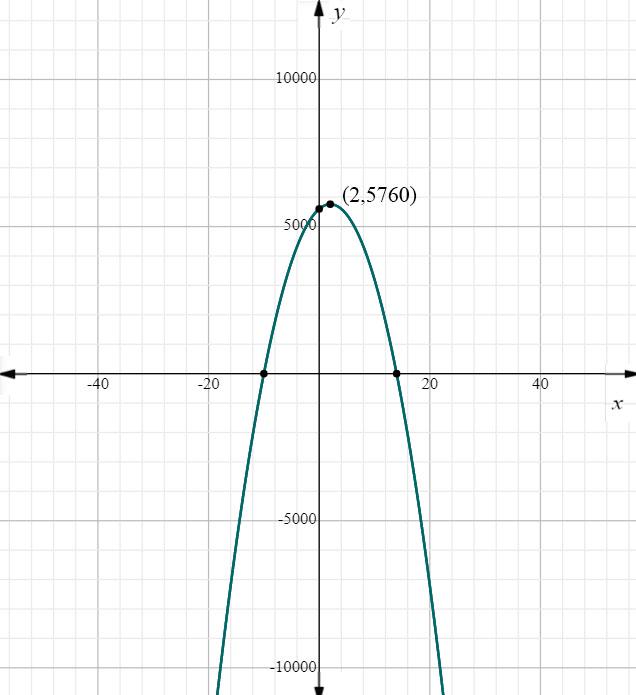
Therefore, the required graph of the revenue function R(x)=(14−1x)(400+40x) is

Page 181 Problem 7 Answer
From previous part of the problem, we already have the revenue function
R(x)=(14−1x)(400+40x)
where x represents the number of increases to her price. and graph of this function:
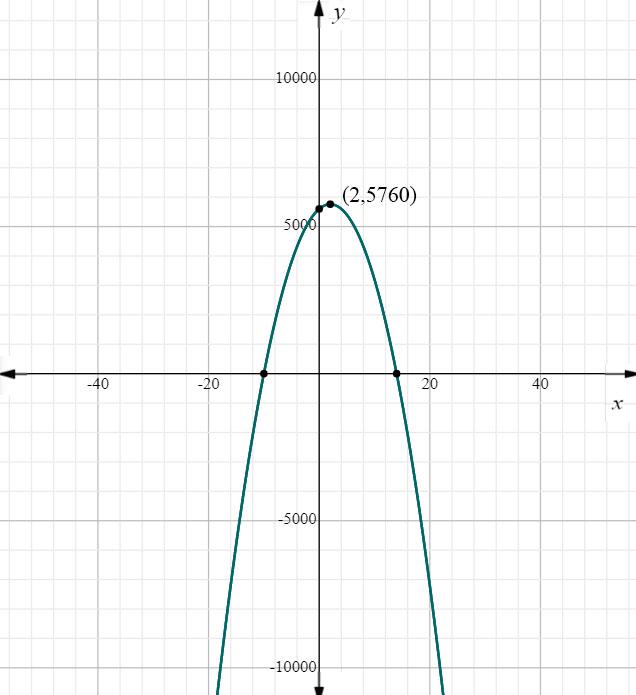
The graph of the given revenue function is a parabola which opens downwards.
Hence, the maximum value is corresponding to the x−coordinate of the vertex.
From graph, the vertex is (2,5760).
Hence, Maximum possible revenue is $5760.
Therefore, the maximum possible revenue can Adine expect is $5760.
Mcgraw Hill Precalculus Textbook Answers
Page 181 Problem 8 Answer
From previous part of the problem, we already have the revenue function
R(x)=(14−1x)(400+40x)
where x represents the number of increases to her price.
and graph of this function:
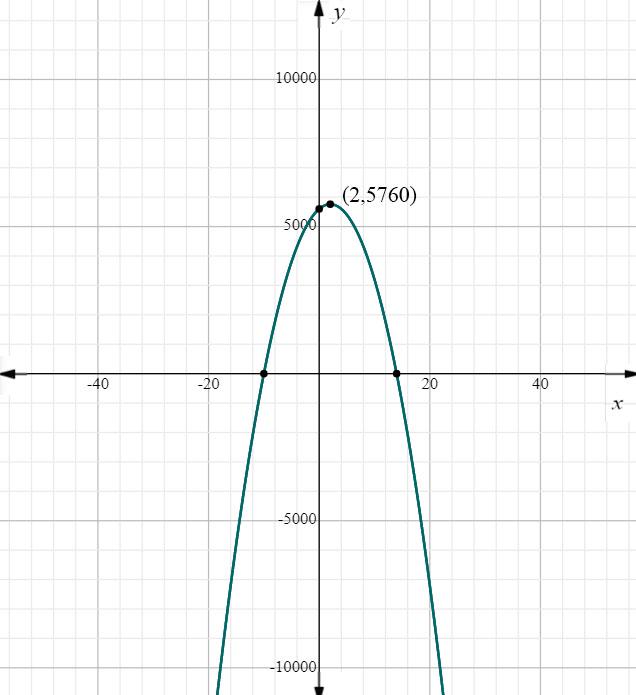
The graph of the given revenue function is a parabola which opens downwards.
Hence, the maximum value is given by the y−coordinate of the vertex.
From graph, the vertex is (2,5760).
Hence, Maximum possible revenue is obtained by 2 times increase in her price.
That is, Cost per Mukluk
=400+40x
=400+40(2)
=400+80
=480
Therefore, selling at $480 price would give her the maximum possible revenue.
Mcgraw Hill Precalculus Textbook Answers
Page 181 Problem 9 Answer
Given Function:
R(x)=−40(x−2)2+5760
From the previous problem, we have Adine’s function,
R(x)=(14−1x)(400+40x)
Now we expand the given functionR(x)=−40(x−2)2+5760
R(x)
R(x)=−40(x−2)2+5760
=40(−(x−2)2+144)
=40(−x2+4x−4+144)
=40(−x2+4x+140)
=40(−(x+10)(x−14))
=−40(x+10)(x−14)
=40(x+10)(14−1x)
=(40x+400)(14−1x)
=(14−1x)(400+40x)
On comparing this with Adine’s function, both are same.
Therefore, function given by Adine’s friend and function by Adine are both same.
Page 181 Problem 10 Answer
Given: – R(x)=−40(x−2)2+5760
To find out: – Determine the best price and maximum revenue.
Process used: – Vertex model form
R(x)=−40(x−2)2+5760
For best price, x−2=0
x=2 Maximum revenue R(x)=5760
Hence, Best price is 2 and maximum revenue 5760
Page 193 Problem 11 Answer
Given: The equation of quadratic function is f(x)=−2x2+12x−10.To get the vertex form y=a(x−p)2+q, complete the square.
For completing square, first out the leading coefficient as a common factor from first two terms and, then add and subtract the square of half of the coefficient of x-term to make a perfect square trinomial.
Take the leading coefficient that is −2 common out from first two terms.
f(x)=−2(x2−6x)−10
Now, coefficient of x is −6, and half of −6 is −3.
So, add and subtract the square of −3 that is 9 inside the bracket.
f(x)=−2(x2−6x+9−9)−10
Group the perfect square trinomial and simplify to get the vertex form.
f(x)=−2[(x2−6x+9)−9]−10
⇒f(x)=−2[(x−3)2−9]−10
⇒f(x)=−2(x−3)2+18−10
⇒f(x)=−2(x−3)2+8
So, the obtained vertex form is f(x)=−2(x−3)2+8.
Therefore, the vertex form of the given quadratic function is f(x)=−2(x−3)2+8.
Mcgraw Hill Precalculus Textbook Answers
Page 193 Problem 12 Answer
Given that the quadratic equation f(x)=−2x2+12x−10.
To verify the answer to the graph of the equation.
Consider the equation f(x)=−2x2+12x−10.
Substitute f(x)=0 and simplify the equation as follows:
−2x2+12x−10=0
x2−6x−5=0
x2−5x−x−5=0
x(x−5)−1(x−5)=0
(x−1)(x−5)=0
x=1,5
The graph of the equation is as follows:
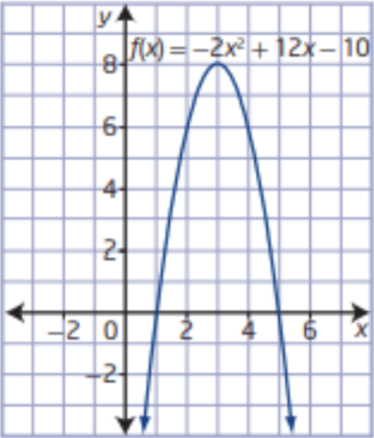
Since the values from the simplify the equation and the graph is x=1,5.
Thus the value of x=1,5.
Page 193 Problem 13 Answer
If a quadratic function is in the vertex form y=a(x−p)2+q , the vertex is (p,q).
Also at x=p,f(x) attain its maximum or minimum value.
Given quadratic function is y=−4x2+20x+37
=−4(x2+5x)+37
=−4(x2+5x+(5/2)2−(5/2)2)+37
=−4(x2+5x+(5/2)2)−(4)(5/2)2)+37
=−4(x+5/2)2+(4)(25/4)+37
=−4(x+5/2)2+62
Hence vertex is (p,q)=(−5/2,62). So the maximum value is attained at x=−5/2
The Maximum value for given quadratic function y=−4x2+20x+37 is 62.
The domain of y=−4x2+20x+37 is the possible values of x, which is −∞<x<∞,x∈R.
The range of y=−4x2+20x+37 is the possible y, which is −∞<x≤62,y∈R.
For the given y=−4x2 +20x+37, maximum value, domain and range of y are obtained.
Precalculus Textbook Mcgraw Hill Answers
Page 193 Problem 14 Answer
If the quadratic function is in vertex form y=a(x−p)2+q, then based on a, vertex (p,q) and the axis of symmetry x=p we can find maximum or minimum value , domain and range of f(x).
Given quadratic function is y=−4x2+20x+37 and its vertex form is y=−4(x+5/2)2+62, where a=−4, vertex is (p,q)=(−5/2,62).
Now since a<0 given quadratic function is open downwards, which attain maximum value only.
Also maximum value attain at axis of symmetry x=−5/2.
Domain is the possible value of x in f(x). Here no restriction for x in y=−4(x+5/2)2+62.So domain is −∞<x<∞,x∈R.
Range is the possible value of y . Here for any x value , maximum value of y is 62.
Hence the range of y is −∞<x≤62,y∈R
Strategies to find out maximum or minimum value, domain and range of y=−4x2+20x+37 are mentioned.
Page 193 Problem 15 Answer
If a quadratic function is in the vertex form y=a(x−p)2+q , the vertex is (p,q).
Given quadratic function is y=12x2−78x+126
=12(x2−78/12x)+126
=12(x2−13/2x)+126
=12(x2−13/2x+(13/4)2−(13/4)2)+126
=12(x2−13/2x+(13/4)2)−(12)(13/4)2+126
=12(x−13/4)2−507/4+126
=12(x−13/4)2−3/4
Hence vertex is (p,q)=(13/4,3/4)
For the given quadratic function y=12x2−78x+126 the vertex is (13/4,−3/4).
Precalculus Textbook Mcgraw Hill Answers
Page 194 Problem 16 Answer
If the coefficient of x2 is 1, no need to take that coefficient outside.
Make sure that symbols in between the terms are correct in all the steps.
Also we have to take the half of the coefficient of x carefully.
In the second line of given equations, 8x is wrongly write as 4x.
Also we have to add and subtract the square of half the coefficient of the x term.
Here 16 should be added not 4.
These are the mistakes.
Now correct vertex form is, V=x2+8x+30= (x2+8x+42−42)+30
= (x2+8x+16)−16+30
=(x+4)2+14
In the given conversion of vertex form for V=x2+8x+30,errors are identified and finally correct vertex form V=(x+4)2+14 is obtained.
Page 194 Problem 17 Answer
If the coefficient of is a, take that coefficient outside.
Make sure that symbols in between the terms in each step.
Take the half of the coefficient of x carefully.
We have add and subtract square of half of the coefficient x.
But in the second line of given equations, instead of (9/4)2=5.0625 they added 20.25.
Also in the last line coefficient of (x−4.5)2 is 2, which is disappeared.
These are the errors.
And the correct vertex form is f(x)=2x2−9x−55
=2(x2−9/2x)−55
=2[x2−9/2x+(9/4)2−(9/4)2]−55
=2[x2−9/2x+(9/4)2]−(2)(81/16)−55
=2[x−(9/4)]2−521/8
=2[x−2.25]2−65.125
Conversion of vertex form of 2x2−9x−55, errors are identified and finally correct vertex form is obtained.
and the correct quadratic equation is f(x)= 2(x−2.25)2−65.125
Precalculus Textbook Mcgraw Hill Answers
Page 194 Problem 18 Answer
Given Equations:

We have to Identify, explain, and correct the error(s) in the following examples of completing the square.
There is an error in the third line of the solution. You need to add and subtract the square of half the coefficient of the x−term.
The Correct solution is:
y=8x2+16x−13
y=8[x2+2x]−13
y=8[x2+2x+1−1]−13
y=8[(x2+2x+1)−1]−13
y=[(x+1)2−1}−13
y=8(x+1)2−8−13
y=8(x+1)2−21
Hence, There is an error in the third line of the solution.
You need to add and subtract the square of half the coefficient of the x−term.
The correct quadratic equation is: y=8(x+1)2−21 respectively.
Page 194 Problem 19 Answer
Given Equations:
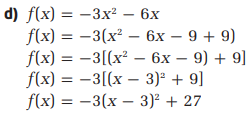
We have to Identify, explain, and correct the error(s) in the following examples of completing the square.
There are two errors in the second line of the solution.
You need to factor the leading coefficient from the first two terms and add and subtract the square of half the coefficient of the x−term.
There is also an error in the last line.
The −3 factor was not distributed correctly.
The Correct solution is:
f(x)=−3x2−6x
f(x)=−3[x2+2x+1−1]
f(x)=−3[(x2+2x+1)−1]
f(x)=−3[(x+1)2−1]
f(x)=−3(x+1)2+3
Hence, There are two errors in the second line of the solution.
You need to factor the leading coefficient from the first two terms and add and subtract the square of half the coefficient of the x−term.
There is also an error in the last line.
The −3 factor was not distributed correctly.
The correct quadratic equation is: f(x)=−3(x+1)2+3 respectively.
Precalculus Textbook Mcgraw Hill Answers
Page 194 Problem 20 Answer
Given quadratic function is y=−6x2+72x−20.
We need to identify, explain and correct any errors in the solutions of Austin and Yuri.
Convert the given quadratic function into vertex form by completing the square.
Austin made a mistake in writing the remaining factors after taking−6 as common factor from first two terms of the given function.
He has written+12x, it should be−12x.
Also he forgotten to square the quantity(x+6) in the last step.
The correct answer should bey=−6(x−6)2+196.
Yuri has written−216 after multiplying−6 by−36. It should be 216 to get the correct answer.
The correct answer should bey=−6(x−6)2+196.
The correct way of getting vertex form of given quadratic function is,
y=−6×2+72x−20
⇒y=−6(x2−12x)−20
⇒y=−6(x2−12x+36−36)−20
⇒y=−6((x−6)2−36)−20
⇒y=−6(x−6)2+216−20
⇒y=−6(x−6)2+196
The correct vertex form is y=−6(x−6)2+196.
Page 194 Problem 21 Answer
Given quadratic function is y=−6x2+72x−20.
Austin’s solution is y=−6(x+6)+196 and Yuri’s solution is y=−6(x−6)2+236.
We need to show several methods that they could have used to verify their solutions.
To verify the answers, either work backward from obtained vertex form to show the functions are equivalent or use graphing utility to show the graphs of both the functions are identical.
If their solution is incorrect, then working backward gives different function other than given function.
If their solution is incorrect, then the graphs of given function and obtained function in vertex form are not identical.
To verify the answers, either work backward from obtained vertex form to show the functions are equivalent or use graphing utility to show the graphs of both the functions are identical.
Page 195 Problem 22 Answer
Given that a particular parabolic microphone has a cross-sectional shape that can be described by the function d(x)=0.03125x2−1.5x, whered is the depth, in centimeters, of the microphone’s dish at a horizontal distance of x centimeters from one edge of the dish.
We need to use an algebraic method to determine the depth of the dish, in centimeters, at its center.
For this, find the vertex by completing the square and then substitute the x-coordinate of the vertex in the given equation.
Consider the given equation,
d(x)=0.03125x2−1.5x
⇒d(x)=0.03125(x2−48x)
⇒d(x)=0.03125(x2−48x+576−576)
⇒d(x)=0.03125((x−24)2−576)
⇒d(x)=0.03125(x−24)2−18
Now comparing with d(x)=a(x−p)2+q, we get a=0.03125,p=24 and q=−18.
Therefore vertex is(p,q)=(24,−18).
Now putx=24
ind(x)=0.03125x2−1.5x, we get
d(24)=0.03125(24)2−1.5(24)
=18−36
=−18
But the distance cannot be negative. Therefore,
The depth of the dish is 18 centimeters at its center.
The depth of the dish is 18 centimeters at its center.
Precalculus Textbook Mcgraw Hill Answers
Page 195 Problem 23 Answer
Given that a concert promoter is planning the ticket price for an upcoming concert for a certain band.
At the last concert, she charged $70 per ticket and sold 2000 tickets.
After conducting a survey, the promoter has determined that for every $1 decrease in the ticket price, she might expect to sell 50 more tickets.
We need to the maximum revenue that the promoter can expect and the ticket price will give that revenue.
For this, first find revenue function and then convert it into vertex form.
Letx be the number of price decreases. Then the new price is70−x and the number of tickets sold is2000+50x.
Now the revenue is,
R=price×quantity
⇒R(x)=(70−x)(2000+50x)
⇒R(x)=140000+3500x−2000x−50x2
⇒R(x)=−50x2+1500x+140000
Now by completing the square, we get
⇒R(x)=−50(x2−30x)+140000
⇒R(x)=−50(x2−30x+225−225)+140000
⇒R(x)=−50((x−15)2−225)+140000
⇒R(x)=−50(x−15)2+11250+140000
⇒R(x)=−50(x−15)+151250
Now comparing with R(x)=a(x−p)2+q, we get
p=15 and q=151250
Hence maximum revenue is$151250 and the ticket price is$70−$15=$55.
Maximum revenue is $151250 when the ticket price is $55.
Page 195 Problem 24 Answer
Given that a concert promoter is planning the ticket price for an upcoming concert for a certain band.
At the last concert, she charged$70 per ticket and sold 2000 tickets.
After conducting a survey, the promoter has determined that for every $1 decrease in the ticket price, she might expect to sell 50 more tickets.
We need to find the number of tickets that the promoter expect to sell at the price of $55.
For this, substitute x=15 in the equation representing the number of tickets sold.
Let x be the number of price decreases. Then the new price is70−x and the number of tickets sold is 2000+50x.
Now putx=15 in2000+50x, we get
2000+50(15)=2000+750=2750
Hence the promoter can expect to sell 2750 tickets.
Page 195 Problem 25 Answer
Given that a concert promoter is planning the ticket price for an upcoming concert for a certain band.
At the last concert, she charged$70 per ticket and sold 2000 tickets.
After conducting a survey, the promoter has determined that for every $1 decrease in the ticket price, she might expect to sell 50 more tickets.
We need to Explain any assumptions the concert the promoter is making in using this quadratic function to predict revenues.
The promoter can assume that the decrease in ticket prices determines the same increase in ticket sales as indicated by the survey.
The revenue may increase as the ticket price decreases.
The decrease in ticket prices determines the same increase in ticket sales as indicated by the survey.
